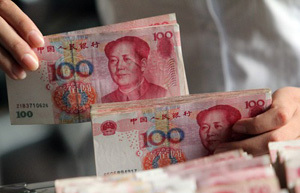Growth in China's shadow banking activity continues to outpace that of nominal GDP but has begun to stabilize, says Moody's in its quarterly monitor released on Monday.
The report notes that in Chinese mainland, share of shadow banking components, including entrusted loans, trust loans and bill acceptances, in the stock of total social financing was equivalent to 35 percent of GDP by the end of August this year.
"In recent quarters, data suggests that credit growth associated with the shadow banking sector has begun to stabilize and that traditional bank lending has instead increased faster," said Michael Taylor, a Moody's Managing Director and Chief Credit Officer for Asia Pacific.
Share of formal bank loans slightly picked up in August 2014 to 61.6 percent from 54.8 percent at the end of 2013, while those shadow banking components included in the total social financing flows edged down to 19.5 percent from the peak of 29.9 percent last year, according to the report.
"Despite the authorities' efforts to rein in the growth of credit, shadow banking activity on the mainland continues to clock faster growth than nominal GDP, indicating that related leverage in the economy is still rising," said Taylor in Moody's Quarterly China Shadow Banking Monitor.
The agency estimated that China's shadow banking assets reached 37.7 trillion yuan at the end of 2013, or around 66 percent of GDP, compared to 52 percent at the end of 2012.
Risks from property sector exposures are increasing, as real estate and infrastructure account for one third of all trust loan exposures, according to the report. Loans made by trust companies accounted for 6.8 percent of total bank loans by the end of second quarter 2014.
Moody's noted in its quarterly report that significant risks within China's shadow banking remain due to rapid growth and lending concentration.
The rating agency launched its first Quarterly China Shadow Banking Monitor on Sept 22, focusing on potential risks to both Chinese financial system and real economy, by analyzing publicly available data.
Shadow banking, as has been defined by the Financial Stability Board, is "credit intermediation involving entities and activities, fully or partially, outside the regular banking system", or non-bank credit intermediation in short.
|
 |
 |
| Top 10 regions with highest reliant on property investment | Central bank injects SLF into major banks |
